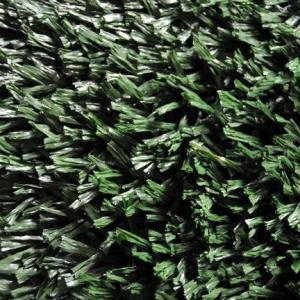drainage system.
Density of the grass – predetermined number of fibers per square metre of surface or the number of embedded fibre bundles. The density of grass influences the firmness of the ground and it should match the type of infill and of the intended use of the surface. A grass with higher density does not always mean a better surface.
Dtex – defines the weight of fibre. A grass from the range from 6.600 to 16.000 Dtex is used (it is a weight in grammes of a 10 km-long fibre).
Fibre thickness – parameter which defines thickness of the material of which the fiber is made (in micrometres).
Monofilament fibers – separate, flat and firm fibres. Monofilament fibers are thicker than fibrillated fibers and therefore they are more elastic and more resistant to abrasion and breaking. The fibers come in various shapes: oval, rectangular, V-shaped, S-shaped, C-shaped, curved or diamond-shaped.
Fibrillated fibers – fibers with additional incisions along their length (split fibers) – it ensures a better stability and elasticity, their disadvantage is that they wear faster.
Infill – a loose material put between the fibers. It stabilises grass fibres (blades), improves elasticity and slip-resistance. Depending on the intended use of the surface, the infill is made of a quartz sand or synthetic granules (SBR, EPDM, TPE).
| Foundation Fabric | Two layers of PP cloth & SBR Glue |
| Fabric | PE |
| Dtex | 6600 |
| Width | 1mm |
| Pile height | 50mm |
| Stitch rate | 20stich/10cm |
| Gauge | 3/4inch |
| Yan Weight | 2kg/sqm |
| Application | football grounds and others |



